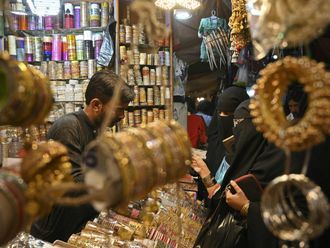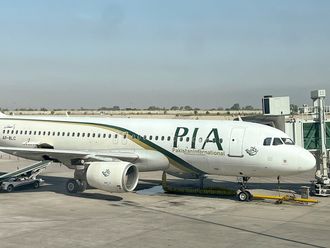JHELUM, Pakistan: Outside an old farmhouse nestled among green fields, two men lay on a cot. With their feet propped against a teal-painted wall, they stared at a sky speckled with clouds, occasionally pointing upward and aiming a pair of binoculars. The dark figure of a bird would suddenly be visible at a great height, gliding across the heavens, then flying out of view just as swiftly as it had appeared.
Bird watching is no idle exercise in these parts of Pakistan. Aloft that afternoon was a rare breed of racing pigeon worth hundreds of dollars — more than either man observing it earned in a month.
The pigeon is part of a stable of prized high-fliers belonging to Raja Iftikhar Ahmad, a businessman whose farm on the placid Jhelum River has become a rearing ground for big-time birds. More than 300 of the winged specimens flap and flutter inside a series of custom-built, walk-in coops on the roof of Ahmad’s farmhouse. Tall and broad-shouldered, with an enviably thick moustache, Ahmad welcomed a visitor into the enclosure, its royal blue paint spattered with droppings.
“To your eyes they look like normal pigeons,” he said, pulling down one bird with a gray-blue crown and white feathers. He held it by the claws and lifted a wing to reveal a deep streak of indigo dye, applied as a sort of marathoner’s bib for the endurance races popular here.
People train pigeons all over the world – there are believed to be thousands of “pigeon fanciers” across the United States – but in Pakistan the niche pursuit boasts a particularly rich history. In the Mughal era, beginning in the 16th century, legend has it that carrier pigeons delivered secret messages from royals to their men on the battlefield, or to their women in harems.
No starting line
Nowadays, pigeon breeding, or kabootar parwar, is more of a hobby, though a serious one for men like Ahmad. In the endurance races popular here, pigeon enthusiasts train their birds to stay aloft for as long as possible – usually for more than 12 hours at a stretch – before returning home.
There is no starting line: all the birds in a competition take off at the appointed time from their own perches, often many miles apart. The breeders watch from the ground with binoculars, but often the pigeons are out of sight. The moment one returns to its perch, the clock stops; landing anywhere else can mean disqualification — if the bird is caught.
Judges circulate among the breeders and perform spot checks, but the competitions are based largely on the honour system. Each pigeon wears a silicon band around one leg with its owner’s phone number, to help track strays.
“They are trained not to land anywhere else,” Ahmad said. “This is a matter of respect for our sport.”
Three times, he has won an annual tournament here in the eastern province of Punjab. Five years ago, he was runner-up in an international competition hosted by the UAE, when his birds flew for a combined 1,082 hours over 11 days.
Once someone asked Ahmad to part with one of his best fliers, a blue-headed female Sialkot pigeon named Topiwali (“the one with the cap”), in exchange for a new Toyota sedan. Iftikhar declined. “This is more than a game for us,” he said. “It’s a tradition.”
Ahmad, 44, learnt the pastime from his father, who picked it up while working for a royal family in the Arabian Gulf. When Ahmad moved to Britain about two decades ago, he tried to breed pigeons on the roof of his home outside London, but he found the wet, gray conditions less than ideal. His flock seems to do better on the rooftop in Jhelum, a farming area two hours outside Islamabad.
The afternoon before a recent race, his best birds — including three that he said were gifts to him from Bahraini royalty — were resting inside the wire enclosure. Later, as part of the pre-race routine, they would have their wings massaged.
Downstairs, an elderly man ground up food for the birds in a large pot. Here was the secret of a successful pigeon breeder, Ahmad said: If you fed the birds well, they could fly for hours and hours without feeling fatigue.
He was circumspect about the exact composition of his prize-winning formula, but it was a mixture of gram, millet, almonds, cardamom, herbs and, at times, enhancers that have been banned from other sports.
“The steroids keep them from getting thirsty, so they can fly for 10 or 12 hours,” he explained. “It’s allowed. So are muscle relaxers. You can do anything you want in this sport, really. I’ve even fed the pigeons Viagra.”
Ahmad allowed that to settle in for a moment, then broke into a grin – a subtle acknowledgement that the diet might not exactly be healthy for the birds.
— Los Angeles Times












